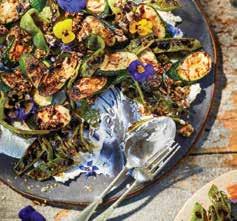PARENTING FOR KINDNESS
WHAT IS MY CHILD’S LEARNING STYLE?
KEEPING YOUR SPACE COOL IN THE HEAT
HOW TO CONNECT WITH YOUR TEEN
EDITOR’S BEAUTY PICKS


PARENTING FOR KINDNESS
WHAT IS MY CHILD’S LEARNING STYLE?
KEEPING YOUR SPACE COOL IN THE HEAT
HOW TO CONNECT WITH YOUR TEEN
EDITOR’S BEAUTY PICKS


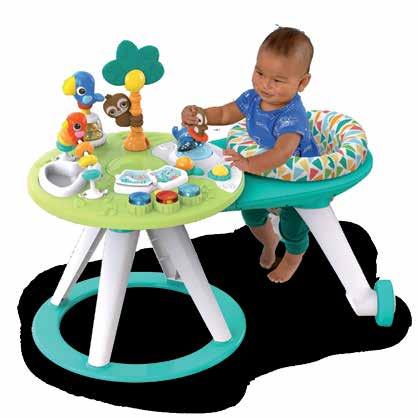
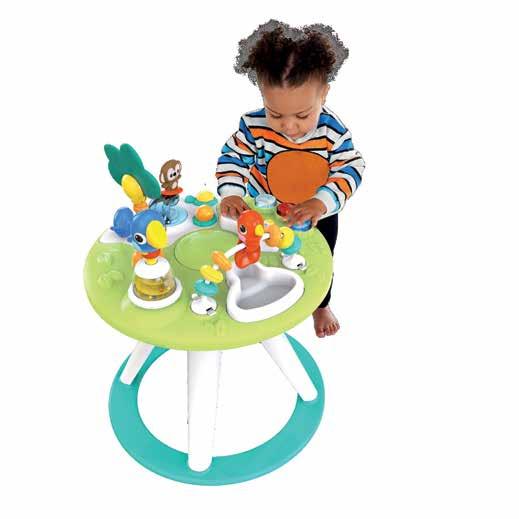





EDITORIAL
Editor: Ella Naseeb Ryan ella.ryan@cpimediagroup.com
Online Editor: Daniel Shepherd daniel.shepherd@cpimediagroup.com
ADVERTISING
Group Sales Director: Liz Smyth liz.smyth@cpimediagroup.com
Sales Director: Mathew Tharakan mathew.tharakan@cpimediagroup.com
Sales Director: Gill Fairclough gill.fairclough@cpimediagroup.com
Sales Director: Carol Owen carol.owen@cpimediagroup.com
Sales Manager: Yash Gehlot yash.gehlot@cpimediagroup.com
Consultant: Ivan Grbic ivan.grbic@cpimediagroup.com
MARKETING, DISTRIBUTION & SUBSCRIPTIONS info@cpimediagroup.com
DESIGN
Froilan A. Cosgafa IV
FOUNDER
Dominic De Sousa (1959 - 2015)
PRINTED BY Wellpack Printing Press LLC
FOR OTHER ENQUIRIES, PLEASE VISIT: motherbabychild.com
MBCMagazine
PUBLISHED BY
HEAD OFFICE: Office 1307, DSC Tower, Dubai Studio City, Dubai, UAE P.O. Box 13700 Tel: +971 4 568 2993 Email: info@cpimediagroup.com
A publication licensed by Dubai Production City, DCCA © Copyright 2025 CPI Media Group FZ LLC. All rights reserved.
While the publishers have made every effort to ensure the accuracy of all information in this magazine, they will not be held responsible for any errors herein. cpimediagroup.com
Hello Mum!
When was the last time you really relaxed and rested? I don’t mean squeezing in some exercise or collapsing into bed after putting everyone to sleep. I mean the deep, meaningful kind of rest our bodies - and kids’ growing brains - really need.
With the summer holidays now in full swing and children at home, embracing ease can feel like a faraway dream. Here’s the truth though - it’s not a luxury, it’s a need, for adults and kids alike!

That’s why our July issue leans into the idea of slowing down.
On page 16, we unpack why teaching kids to rest matters, and how rest is actually a learnable skill. It’s a gentle reminder that helping little ones to mindfully unwind supports not just their wellbeing, but their emotional resilience too. If you’ve ever wondered why your child seems constantly ‘wired’ or can’t settle down, this one’s for you.
Of course, summer heat doesn’t help with energy levels! Staying hydrated is a huge part of keeping kids calm and healthy in hot weather, so we’ve pulled together some handy tips on page 18 about how much water children really need - plus clever ways to encourage them to drink more of it.
For parents navigating the teen years, you’ll know how tricky it can be to keep an easygoing connection with your teenager. Turn to page 26 for practical advice and simple ways to stay close during the turbulence of adolescence - even when conversation seems minimal!
Don’t miss our article on discovering your child’s learning style on page 33 - perfect if you’re looking to support their confidence and reduce any academic frustration. Understanding how they intake information best is a great way to make learning as smooth and easy as possible.
Elsewhere, on page 28, we tackle what to do if your toddler struggles with being apart. If you’re facing clingy goodbyes or teary mornings, this piece aims to guide you through with empathy and some simple, loving ways to ease transitions for you both.
For families daydreaming about escape, page 38 takes you to a summer camp in the Maldives that’s as exciting for kids as it is relaxing for parents. Think crystal waters, beachside talent shows, marine adventures and more. Or if you’re staying put, we’ve got some excellent tips over on page 41 for keeping your home cool and calm on sticky summer days.
And because relaxation doesn’t have to mean travelling far, my beauty picks for July focus on an ‘at-home spa kit’, to help you carve out a few peaceful moments at home. You’ll find everything from glow-boosting masks to candles and serums. Flip to page 49 to take a look - it’s about little luxuries that make a big difference.
As usual, I’m not going to spill all the beans here and hope you’ll enjoy discovering this edition for yourself! Wishing you a relaxed, calm month - and hopefully a little rest along the way!
Happy reading!
Ella Editor
Mother, Baby & Child Magazine
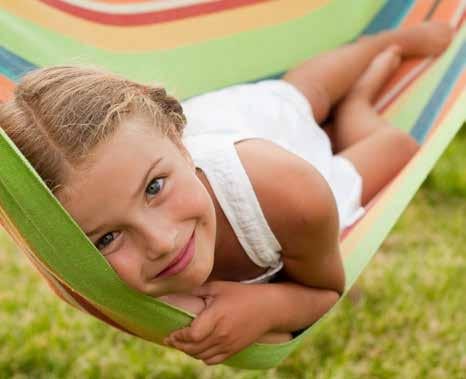
Born in Brooklyn, raised in the UAE and beloved for its low-cal, keto-friendly, vegan and protein-packed creations, The Brooklyn Creamery is redefining what frozen treats can be - proving that indulgence doesn’t need to be unhealthy!
This summer, they’ve introduced their new 99 Calorie Caramel Crunch Sundae and it’s already setting a new standard for better-for-you desserts in the region. Rich caramel ribbons, a golden crunch and velvety texture all come together in one creamy, noadded-sugar cup of joy - how good does that sound?!
If you’re more of a chocolate person, I recommend my latest obsession - their Vegan Chocolate Truffle Bonbons. These are delicious bite-sized treasures with a silky centre and rich cocoa coating. They’re my go-to when I want something indulgent but plant-based, and they never disappoint.
What I love most is that The Brooklyn Creamery’s offerings feel like a treat, not a compromise. Whether you’re staying on track with wellness goals or just looking for a smarter sweet fix, these frozen goodies are the ideal summertime snack!
Available on Talabat, Deliveroo, Noon Food and Careem, these desserts are light, luscious and loaded with flavour - what’s not to love?!
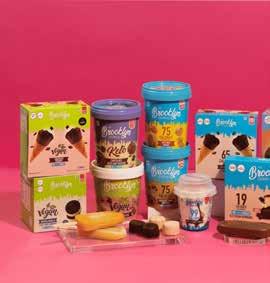







Get your forks ready - Summer Restaurant Week is back until July 13th, and it’s shaping up as one of the tastiest events of Dubai’s summer calendar. Part of Dubai Summer Surprises (DSS), this annual celebration invites food lovers to explore the city’s top dining spots at irresistible prices, with two-course lunches for AED 95 and three-course dinners for AED 150.
This year, over 55 restaurants are participating and the line-up is a foodie’s dream - from homegrown gems to internationally acclaimed favourites, there’s something for every craving.
Some of my must-try picks include Asian 5 - One Central for bold Southeast Asian street flavours in a buzzing setting and Kinara by Vikas Khanna for rich Indian spice meets fine-dining finesse. I’d also recommend Al Fanar Seafood Market & Restaurant for some fresh Emirati seafood, like shrimp machboos and seabass tanoor - all in a charming retro setting surrounded by park views!
Tables fill up fast, so definitely book your spot early on OpenTable. Whether you’re dining out with friends, celebrating a summer birthday or you just love a good deal, this is the perfect excuse to try something new - or revisit an old favourite.

Rooftop Pilates classes; soothing spa treatments for children; authentic Italian food for the whole family and more!
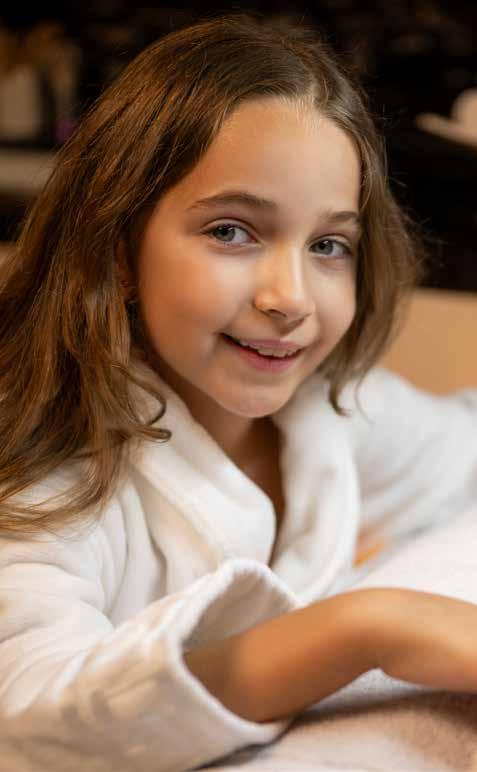

Palazzo Versace Dubai is extending its luxury wellness philosophy to the younger generation with an exclusive new offering at The SPA. Designed specifically for children and teens aged 6 to 17, these beautifully curated treatments help kids discover the benefits of relaxation, mindfulness and self-care in an elegant, nurturing environment - how good does that sound?!
The setting is the spa’s iconic Versaceinspired interiors, brought to life with gentle lighting, soothing aromas and expert therapists trained to work with younger guests. Each treatment uses hypoallergenic, fragrance-free oils and age-appropriate techniques to ensure comfort and care at every stage. With a growing focus on mental wellbeing and stress relief in children, these offerings give parents an innovative and safe way to introduce wellness rituals to little ones.
This full-body massage is ideal for kids who need a little grounding. Using soft, rhythmic strokes and soothing oils, it helps ease growing bodies and quiet racing minds. Whether it’s after a busy week at school or ahead of a good night’s sleep, this 45-minute treatment is perfect for unwinding. It’s also excellent for children involved in sports or physical activity, aiding muscle recovery and improving sleep quality.
Duration: 45 minutes
Pricing: AED 420
Ages: 6 - 17
A gentle scalp and head massage, this one is designed to melt away stress and screen fatigue. With options for a 15 or 30-minute session, it’s a quick fix that promotes calm, especially helpful before bed or after long hours of digital activity. It’s also an ideal choice for children prone to anxiety or restlessness, offering a serene pause in their day.
Duration: 15 minutes - AED 160; 30 minutes - AED 280
Ages: 6 - 17
This focused treatment targets tension in the neck, shoulders and back - the typical areas affected by device use. It’s a thoughtful introduction to body awareness and posture care, wrapped in a grounding, luxury spa experience. Parents will appreciate how this massage supports better posture in kids, eases any physical discomfort and reinforces healthy habits in a digital age.
Duration: 30 minutes
Price: AED 320
Ages: 6 - 17
All treatments require parental consent and children under 12 must be accompanied by a parent or guardian during the session. Each experience is designed not only to pamper, but to educate too, helping young guests build lifelong habits of relaxation and self-care.
For bookings and more information, call +971 4 556 8750 or email spa@palazzoversace.ae.

Set on the mezzanine floor of Address Beach Resort, Farina is a chic Italian dining destination that blends the warmth of coastal Italy with the vibrant energy of JBR. Perfect for date nights, sunset meals or a leisurely weekend get together, Farina invites you to relax into la dolce vita with panoramic views of Bluewaters Island and Ain Dubai.
Elevate your fitness routine (literally!) this summer with Studio14’s exclusive rooftop Pilates classes at SLS Dubai. Held monthly on the 75th floor pool deck (aka Privilege), these energising sessions deliver sculpting movement and deep breathwork with unbeatable panoramic views of the Dubai skyline.
It all kicks off at 8 am, just in time to greet the day from one of the city’s highest rooftops. Whether you’re a Pilates pro or an enthusiastic beginner, the 60-minute mat class is open to all levels and focused on mindful strength, flexibility and posture. The stunning surroundings only add to the experience, turning every stretch and pulse into something a little more magical. Expect a sunrise that bathes the city in gold, an energising playlist and a morning reset like no other.
Each class is hosted by Studio14’s expert instructors, who guide you through a series of movements designed to tone and reset. It’s the perfect way to squeeze in some self-care before the day takes off - or to simply enjoy a moment of calm above the hustle and bustle of downtown.
Location: Privilege, 75th floor, SLS Dubai
Dates: 4th July & 1st August
Timings: From 8 am
Pricing: AED 235 per person
To book your spot or learn more, call +971 4 607 0654 or email spa.reception@slshotels.com.
The menu champions fresh, simple ingredients that shine - think handmade pastas, golden stone-oven pizzas and seafood dishes brimming with Mediterranean flavour. Whether you’re diving into a creamy burrata, twirling forkfuls of truffle linguine or savouring a perfectly crisp fritto misto, every bite is a tribute to Italy’s culinary soul.
Inside, the space is stylish but comfortable, with open-air vibes and elegant décor. By day, it’s breezy and sunlit; by night, it’s moody and romantic. The transition from lunch to late-night dining is seamless, making Farina as versatile as it is delicious.
Location: Farina, Address Beach Resort
Timings: Lunch 12 pm to 4 pm; Dinner 6 pm to 2 am

Call +971 4 8798866 or email dineatbeachresort@ addresshotels.com for bookings and more information.

Wands at the ready - Harry Potter™: The Exhibition is coming to Abu Dhabi! Launching on July 25th at Manarat Al Saadiyat, this spellbinding experience brings the magic of the wizarding world to life, through groundbreaking interactive technology and jaw-dropping set design. It’s the most comprehensive touring Harry Potter exhibition to date, and a must-visit for fans of all ages. Expect cutting-edge displays, movie-quality props and iconic moments that transport you straight into the heart of the Wizarding World. The immersive nature of the experience ensures that every visitor - from casual admirer to devoted superfan - will find something to marvel at.
The exhibition invites you into iconic scenes and settings from the beloved books and films, from the eerie Forbidden Forest to the enchantment of the Great Hall. It’s an all-immersive, choose-yourown-adventure journey, personalised via your very own exhibition wristband. Pick your Hogwarts house, cast spells, test your Quidditch™ skills, and even brew a potion or two. Your choices shape your visit, unlocking unique experiences tailored to your magical persona.
Our recommendations include:
• The Page to Screen Gallery, featuring a rare first edition of Harry Potter and the Philosopher’s Stone inside a Gringottsstyle vault
• The Hogwarts Castle Gallery, where guests see their names on the Marauder’s Map
• The Classrooms Experience, where interactive games and props make magic feel real
• Hagrid’s Hut and the Forbidden Forest, where you can summon a Patronus and meet magical beasts
Whether you’re exploring house crests in the Sorting Hat room, examining costumes from Fantastic Beasts, or browsing exclusive merchandise, the exhibition celebrates every corner of the wizarding universe.
Don’t miss the gift shop, where you can stock up on Hogwarts robes, wands and limited-edition collectibles to take the magic home. Tickets start at AED 115, with VIP options that include fast-track entry, a commemorative tote bag and access to the audio guide.
Harry Potter: The Exhibition has already delighted over 3.5 million fans across cities like Philadelphia, Krakow and Melbourne. Now it’s Abu Dhabi’s turn to discover the magic! This is a once-in-a-lifetime chance to experience Harry’s world like never before - right here in the UAE. Perfect for a summer outing, this extraordinary exhibition promises hours of fun, nostalgia and unforgettable photo ops for kids, teens and adults alike. Grab your friends, your wand and your camera - this magical journey is one you’ll remember long after the last spell is cast.
Location: Manarat Al Saadiyat, Saadiyat Island
Opening date: Friday, 25th July
Pricing: From AED 115
For bookings and more information, visit www.abudhabi.harrypottterexhibtion.com.
Keeping kids hydrated in the heat; the importance of learning to rest for children; C-section recovery tips and more!
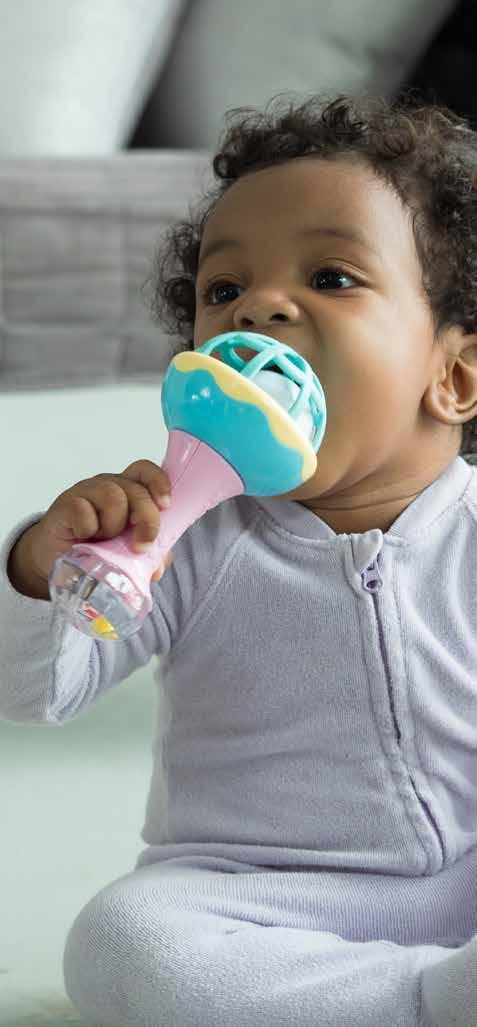

Here’s a closer look at some tried-andtested teething relief methods that are safe, natural and genuinely effective.
Teething can be a challenging stage for babies and parents alike. It often brings with it tears, disrupted sleep, irritability and plenty of dribble. While it’s completely normal, that doesn’t make it easy - especially when your little one seems so uncomfortable and there’s no quick fix in sight.
As parents, we often want to soothe babies safely and effectively without relying too heavily on medicated options. The good news is there are plenty of natural remedies that truly can make a difference - gently easing discomfort while supporting your baby through this developmental milestone.
Most babies start teething around six months old, although it can begin as early as three months or as late as one year. Common symptoms include excessive drooling, swollen gums, increased chewing, fussiness and disrupted sleep. Some babies may also experience mild fevers or changes in appetite.
While teething is a usual developmental process, it’s often distressing - both for your baby and for you. It’s completely natural to feel a bit helpless at times, especially when your regular calming techniques aren’t quite cutting it.
One of the simplest and most effective ways to soothe sore gums is with cold. Cold temperatures help numb the gums slightly and
reduce inflammation, bringing almost instant relief. Just be mindful not to use anything frozen solid - it can be too harsh on tender gums and may cause more harm than good. Here are some ways to use this method:
Wet a clean muslin or flannel cloth, twist it into a rope shape and place it in the fridge for 15-20 minutes. Once cool, let your baby chew on it under supervision.
A cold metal spoon (kept in the fridge) can be gently rubbed along your baby’s gums for a bit of relief.
Opt for BPA-free, food-grade silicone or rubber teething rings that can be refrigerated (not frozen). Always check for wear and tear and clean them thoroughly after each use.
Babies love to explore the world with their mouths - especially when teething! Providing safe, chewable toys not only soothes your little one, it also distracts them. Natural rubber and food-grade silicone teethers are popular choices for a reason - they’re safe, durable and just the right texture for gnawing.

Look for teething toys that are:
ü Free from BPA, phthalates and synthetic dyes
ü Easy to clean (preferably dishwasher safe)
ü Sized appropriately to prevent choking
Sometimes, your baby just wants the comfort of touch. Using a clean finger, gently rub their gums in circular motions. The pressure can help counteract the pain and may provide a bit of welcome distraction too.
Some parents choose to dip their finger in cool water or breastmilk first, which can add another layer of relief. Just be sure your hands are washed thoroughly beforehand.
Feeding is often comforting for teething babies, though it can sometimes become more difficult if sore gums make sucking painful. If your baby wants to feed more often, they
might be seeking comfort rather than hunger - and that’s completely okay.
Breastmilk has natural anti-inflammatory properties and can help ease irritation from the inside out. If you’re bottle-feeding, try offering smaller, more frequent feeds, especially if your baby seems fussy or restless.
Chamomile is known for its calming and antiinflammatory properties. For babies older than six months, a little chilled chamomile tea can be helpful. You can dab it gently on their gums using a clean cloth or let them sip a cooled teaspoon under supervision. However, it’s important to always check with your paediatrician before introducing any new herbs or teas - even in tiny amounts.
If your baby has started solids, offering safe foods to chew on can help massage their gums and offer some respite. Homemade
teething biscuits or soft finger foods like slices of chilled cucumber or carrot (with close supervision) can be a helpful distraction.
Some good options include:
ü Strips of soft fruit (banana, ripe mango, avocado)
ü Plain rice rusks or teething wafers
ü Cooked sweet potato sticks (cooled before serving)
Just remember, choking risks are real during this phase, so never leave your baby unattended while they’re eating or chewing.
One of the lesser-known culprits of teething discomfort is excess dribbling. Constant moisture around the chin and neck area can lead to sore skin and rashes.
It’s good to keep a clean, soft bib on hand and gently pat (not rub) your baby’s chin throughout the day. You can also apply a thin layer of baby-safe barrier cream to protect their skin from irritation.
It’s important to be cautious about what goes into your baby’s mouth during teething. Here are some things to avoid:
ü Teething gels with benzocaine or lidocaine - these numbing agents can be harmful for infants and are not recommended by health authorities.
ü Frozen objects - as mentioned earlier, these can damage sensitive gums.
Teething can test your patience - especially when it affects sleep or leads to more tears than usual. Trust that this phase will pass. Your little one won’t remember the discomfort, but they will remember the love and care they received throughout it.
Keep things simple, follow your baby’s cues and don’t be afraid to reach out for support if you need it. There’s no one-size-fits-all solution to teething. What works wonders for one baby might not make a difference to another. The key is to stay calm, keep trying different natural options and offer as much comfort and cuddles as you can along the way.

Just like learning to spell, manage big feelings or build friendships, rest is a skill - one that needs nurturing.

In a world that glorifies busyness and hustle, rest can easily fall to the bottom of the priority list - even for children. From after-school activities and homework, to playdates, classes and screen time, many kids’ days are packed from morning to bedtime. While staying active and engaged can be a positive thing, it’s just as important to teach our children that slowing down has value too.
Rest isn’t just about sleep. It’s about creating space for stillness, calm and recovery. For
children, rest supports every area of their development. Physically, downtime gives their body a chance to repair and recharge. Emotionally, it offers kids the opportunity to process their feelings. Mentally, it helps them consolidate learning and strengthens memory. When children are constantly stimulated or on the go, it can be hard for their brains to absorb what they’re learning or make sense of their experiences.
Children need unstructured moments of peace in order to thrive - and when rest is missing, we see the consequences. Increased irritability, trouble sleeping, difficulty
concentrating, emotional outbursts and frequent illness can all be signs that your child’s body and brain are craving a break.
While rest might seem like something that comes naturally, in reality, it’s not always easy for children - especially when they’re used to being constantly entertained or overscheduled. The ability to rest takes practice. It involves:
• Listening to their body and recognising signs of tiredness or overstimulation
• Self-regulation, like winding down without a fuss
• Knowing it’s okay to take a break without guilt or fear of missing out
• Understanding that doing ‘nothing’ is sometimes the most important thing they can do
When children are taught that rest isn’t laziness - it’s wisdom - they begin to develop a healthy lifelong relationship with balance.
So, how can we teach rest in a culture that often rewards constant activity? Here are some ideas to help your child develop this important habit.
Children are natural imitators. If they see you running yourself ragged without breaks, they’re likely to believe that this is how life is meant to be lived. However, if they watch you pausing, taking deep breaths, relaxing without guilt and prioritising sleep, they learn that rest is part of a balanced life.
You might say, “I’ve had a busy day, so I’m going to sit and have a quiet cup of tea for a few minutes” or “I feel tired - I think I’ll lie down early with a book.” These little moments can become great examples of selfawareness and the value of slowing down.
Children thrive on routines, so building restful moments into their daily schedule can help normalise the habit. This could look like having quiet time after school instead of jumping straight into homework or screens. Perhaps it means creating a wind-down ritual before bed (like a warm bath, soft lighting and reading together). Or it could even be making time for weekend ‘nothingness’ - a block of the day where there’s no rushing, planning or obligations.
By creating regular pauses in their schedule, you help kids learn that rest isn’t something that needs to be earned - it’s something they deserve.
In our always-on world, boredom often feels like something to be avoided. But moments of ‘nothing to do’ are actually vital for children. Boredom breeds creativity, reflection and self-led play. It also gives children a chance to notice when they’re tired or in need of calm.
Instead of filling every gap in the day with activities or entertainment, let your little one experience downtime. It might be uncomfortable at first, but over time, they’ll learn how to self-soothe, reflect or simply enjoy their own company - all key parts of true rest.
It’s good to help your child tune into how they’re feeling and learn to listen to their body. You might ask, “How’s your energy today? Do you
feel like you need a rest?” or “It’s okay to say no to something when you’re feeling tired - your body is trying to tell you something.”
Talking about rest as a kind of ‘energy budgeting’ can be helpful, especially for older children. Just like we need to recharge a phone battery, we need to recharge ourselves too.
Rest doesn’t have to mean lying still and doing absolutely nothing. It can be a slow, calming walk, mindful colouring, reading under a blanket fort or listening to gentle music. Some children relax through sensory play, others through yoga or stretching.
The goal is to help your child discover what helps them feel calm, safe and restored - and to frame those things as valuable, enjoyable and worthy of their time.
Of course, rest and sleep go hand in hand. Good sleep hygiene is an essential part of your child’s wellbeing and ability to function day-to-day. Simple tweaks go a long way - such as prioritising an age-appropriate bedtime, limiting screens before bed and creating a soothing wind-down routine. These small, consistent steps will all support better sleep for your child - and better rest overall.
By teaching your child to rest, you’re offering them something more powerful than it might seem at first glance. You’re giving them permission to value their needs. You’re protecting their physical and emotional health and you’re setting the stage for a balanced, grounded adulthood.
In a world that often shouts “go faster, do more”, helping your child to slow down is a radical - and deeply loving - act. So next time your little one needs a break, don’t rush to fill the silence. Instead, honour it, because teaching kids to rest isn’t just about avoiding burnout. It’s about raising calm, self-aware people who know that sometimes, the most important thing they can do…is pause.

We look at ways to encourage little ones to drink more water, especially when the temperature soars.
When you live in a sunny, sweltering place like the UAE, staying hydrated isn’t just a health tip - it’s a daily necessity. While most of us are careful to top up our own water bottles, we might not be quite as mindful when it comes to how much water our children are drinking.
Water is essential for every function in the body - from regulating temperature and supporting digestion, to maintaining concentration and energy levels. Kids are especially vulnerable to dehydration, as their smaller bodies lose water more quickly and they might not always recognise the early signs of thirst.
Dehydration in kids can lead to tiredness, headaches, dizziness, irritability and even

constipation. In hot climates, where outdoor play can leave little ones sweaty in seconds, it’s especially important to keep an eye on their fluid intake.
There’s no one-size-fits-all rule, but general daily guidelines suggest:
• 1-3 years: 4 cups (around 1 litre)
• 4-8 years: 5 cups (around 1.2 litres)
• 9-13 years: 6-8 cups (1.5-2 litres)
• 14+ years: 8-10 cups (2-2.5 litres)
However, in warm climates or on particularly active days, your child may need more.
One simple way to check hydration levels is to have a peek at their urine. If it’s light yellow or clear, you’re on the right track. If it’s darker, they probably need a top-up!
Getting kids excited about water might feel like a stretch, but there are plenty of clever ways to encourage good hydration habits. Let’s take a look!
Kids are far more likely to drink water when it feels like theirs. Why not let them choose a

colourful, reusable water bottle that reflects their personality - whether it features their favourite cartoon character, comes with a built-in straw, or has sparkles that swirl with every sip. A water bottle they love carrying around can turn hydration into an easy habit and even a small source of pride.
Out of sight, out of mind is an old adage for a reason - and it applies to water too! In order to help your child stay hydrated throughout the day, make sure their water bottle is always within reach. Pop it on their playroom desk, place it at the dinner table and tuck it into their backpack for outings. Easy access makes it so much more likely they’ll take regular sips without needing a reminder.

Add flavour
If plain water just isn’t exciting enough, try infusing it with fresh fruit or herbs. Sliced strawberries, cucumber, lemon or mint can add a gentle, natural flavour that keeps kids coming back for more. Not only is this a fun sensory experience, it also steers them away from sugary drinks and builds a healthier longterm habit.
There’s nothing quite like ‘gamifying’ a task to get buy-in from little ones. Turning their water intake into a game can be a genuinely great motivator. You might like to try to use stickers or a fun chart to track how many cups your child drinks each day. You could even
create little rewards or goals based on their progress. This visual encouragement gives children a sense of achievement - and keeps them engaged in the habit without it feeling like a chore.
Parents have enough to think about day-today without adding another job to the list. However, children learn most by watching what we do, not just what we say, so, if they see you regularly drinking water and refilling your own bottle, they’ll be more likely to mimic your behaviour. At least this parenting task has a benefit for your own health too! If possible, try to make hydration part of your family’s everyday rhythm and it won’t be long before your little ones are sipping right alongside you.
Not all drinks hydrate equally. Fizzy drinks and juices often contain sugar or caffeine, which can actually dehydrate the body. While they might be tasty treats, they shouldn’t replace regular water. Where you can, aim to limit these drinks, especially during the hotter months and offer flavoured water or herbal teas as a fun alternative when your child wants something different.
It’s not just about what your child drinkscertain foods can boost their hydration too. As temperatures soar this month, consider offering your child snacks like watermelon, oranges, cucumber and yoghurt, which are packed with water and make refreshing options for hot days. Including these hydrating foods alongside their meals can give kids’ fluid intake an easy boost without them even noticing.
Hydration doesn’t have to be a battle. With a few small changes and a splash of creativity, you’ll soon have your little one sipping awayand staying cool, clear-headed and happy all summer long.
Recovering from a caesarean birth takes time, patience and the right kind of care. Here’s how to support your body, build strength and feel like yourself again after surgery.

For many mothers, a caesarean birth - whether planned or unplanned - can come with mixed emotions. Relief that your baby is here safe and sound. Pride in what your body has achieved. But also pain, tiredness and a sense of uncertainty about how to heal properly.
A C-section is major abdominal surgery and it’s important to honour that. Recovery can look different for everyone, but with gentle movement, smart rest and emotional support, your body will find its way back to strength and balance. So what can you expect during the healing process and how can you make it as smooth as possible?
You’ve just had surgery and brought a baby into the world - two huge physical experiences rolled into one. It’s natural to want to “bounce
back”, but this is a time to go slowly, rest often and let your body do what it’s designed to do - heal.
Your body has been through a lot. Muscle layers were separated, organs gently moved and stitches carefully placed. It’s okay if you don’t feel like yourself straight away. That doesn’t mean anything is wrong - it just means your body is recovering and that takes time.
It might feel impossible to rest when you’re feeding around the clock and adjusting to life with a newborn, but even short, intentional rest periods make a difference. Lie down when your baby naps where you can. Ask for help with meals, housework and nappy changes if you have a ‘village’. Accept every offer of support that comes your way.
If lying flat feels uncomfortable, try propping yourself up with pillows to take pressure off your incision. Side-lying positions for feeding can also help reduce strain on your abdominal muscles and make it easier to rest during long feeds.
Sleep may be patchy at first, but rest doesn’t only mean sleep. Gentle stillness, quiet time and simply staying off your feet all support the healing process.
Your body needs nutrients to rebuild tissue, fight infection and restore energy. It’s best to focus on wholesome, nourishing foods - think protein-rich meals, colourful vegetables, whole grains and plenty of water.

If you’re breastfeeding, your calorie needs will be higher, so don’t be afraid to snack throughout the day. Good options include nuts, dried fruit, hummus with crackers, smoothies and soups. Iron-rich foods like lentils, beans and leafy greens can also help if you lost blood during surgery.
Bone broth, warm herbal teas and gentle stews are traditional postpartum favourites in many cultures - not just for their nutrition, but also for the comfort they provide.
You don’t need to suffer in silence. Pain management is part of recovery and it’s okay to take prescribed medication to help you rest, move and feed more comfortably.
Speak to your doctor or midwife about what’s safe to take, especially if you’re breastfeeding.
If you notice your pain worsening or your medication isn’t helping, be sure to check in with a healthcare professional.
In the first few weeks, avoid heavy lifting (anything heavier than your baby), abdominal exercises or strenuous movement. That said, gentle walking - even for a few minutes around the house - can help circulation, reduce stiffness and boost your mood.
Once your doctor gives the all-clear, you can gradually reintroduce low-impact exercises like walking outdoors, postnatal yoga or Pilates. The focus should be on reconnecting with your core, supporting your pelvic floor and gradually rebuilding strength.
Every woman heals at a different pace. Don’t compare your journey to anyone else’s. Your body knows what it’s doing - just take it one step at a time.
Your C-section incision will go through several healing stages. At first, it may feel tender, swollen or numb - all of which are normal. Over time, the scar will soften and fade, though some sensation changes may last longer.
To help your healing process:
• Keep the area clean and dry
• Wear breathable, high-waisted underwear
• Avoid tight waistbands or anything that rubs
• Support your belly when coughing or laughing with a small pillow
If you notice unusual redness, pus, increased pain or a fever, contact your doctor immediately - these could be signs of infection.
Once your scar has fully closed and you’re feeling ready, you can gently massage the area with oil to help with flexibility and scar tissue - but always wait for the go-ahead from your doctor first.
C-sections can stir up complex feelings. You might feel proud, grateful or even empowered - but it’s also common to feel sadness, frustration or grief, especially if your birth didn’t go as planned. These feelings are completely valid. Talk to someone you trust - a partner, friend, counsellor or support group. You are not alone and sharing your story can be incredibly healing in itself.
Postnatal hormones can also make emotions feel more intense, so give yourself extra kindness during this time. If you notice persistent low mood, anxiety or overwhelm, don’t hesitate to speak to a professional.
Complete recovery from a C-section can take several months and even up to a year for some women. That’s not to say you’ll feel sore or tired for all of that time - but you may notice small changes in your energy, strength and body awareness over the longer term.
Give yourself permission to go gently. This season is about healing, bonding and easing back into your body with care and compassion. Your scar is a mark of love, strength and endurance - and your recovery deserves the same respect!

We sat down with Rena Ovchieva this month, to chat about her experience as a content creator and a mother.
If you’re on the hunt for parenting inspiration with a global twist, look no further than Rena Ovchieva - known to her followers as @ovchieva. This Dubai-based content creator, originally from Russia, is not just a mum; she’s a storyteller, traveler and lifestyle enthusiast.
With a loving husband and a beautiful daughter, Emilia, Rena’s content offers a candid look into the joys and challenges of raising a child in a multicultural household, all set against the backdrop of Dubai’s dynamic landscape.
Staying connected with your teen; raising kind kids; working on separation anxiety and more!
Whether she’s sharing honest reviews of baby products, showcasing family-friendly spots in the city, or offering glimpses into her daily life, Rena’s authenticity shines through. It’s no surprise that she’s been recognised among the top mom influencers in Dubai, collaborating with brands like Pampers and Rotana.
We caught up with Rena to chat about her parenting journey and the stories behind her engaging content.
Rena, would you like to introduce yourself to our readers?
My name is Rena - a girl who arrived in the UAE thirteen years ago with big dreams in her heart. More than anything, I dreamed of having a family, becoming a mom and creating a home filled with love and laughter.
That dream came true - and it grew. Today, I’m not only a mother to a beautiful daughter, but also a content creator sharing our everyday moments, travels and parenting journey, through my platform @ovchieva, I hope to be helpful to other moms and families - to offer support, inspiration and a reminder that we’re never alone in this journey.
You’ve talked about your Russian roots and your husband’s Brazilian heritage. Being a multicultural family, how have these diverse cultures influenced your parenting style?
Actually, I’m mixed myself - my father is Azerbaijani (Muslim) and my mother is Russian (Christian). I grew up celebrating both traditions and


that blend has always been a part of who I am. Now, with my husband Roberto being Brazilian and us living in the UAE, we’ve created a home that embraces it all.
We celebrate Russian, Azerbaijani, Brazilian, and Emirati holidays - from Nowruz, to Christmas. to Carnival. We speak several languages at home and our parenting style is very flexible and open-minded. One day we’re dancing Lezginka, the next day we’re training jiu-jitsu or making a “snowman” out of cotton in the middle of the desert! We’ve even carried Emilia in a sling while exploring traditional markets.
I want my daughter to grow up proud of every part of her identity - to feel deeply connected to her roots and to understand that love, respect and celebration can exist beautifully across cultures. That’s the heart of our family.
What were some of the surprises or challenges you faced when you became a mum in Dubai?
Honestly, becoming a mum far from extended family was both the biggest blessing and the biggest challenge. I was lucky to have my mom by my side for the first month after delivery - and I’ll never forget how much that support meant. But after she left, it really hit me that we were on our own, and that was an emotional shift.
Another big change was adjusting to a completely new lifestyle. For over ten years, I worked in hospitality - intense, fast-paced and nonstop. I barely had time to be at home - but motherhood flipped everything. Suddenly, I was spending entire days and nights at home, caring for a newborn and learning to give myself fully to this new role. Losing that
sense of structure and time for myself was a challenge, but it also taught me how to slow down, embrace the moment and appreciate the quiet, everyday beauty of motherhood.
What’s the one parenting product or service you can’t live without?
I have to say - the hands-free breast pump was a game changer in my early postpartum days! I’m always looking for smart, time-saving solutions that make life with a toddler just a bit smoother.
Your content feels so genuine and relatable. How do you decide what moments to share with your audience and what do you hope they take away from your posts?
First of all, everything I share comes straight from the heart. I don’t try to beautify motherhood or make it look perfect - because it’s not. I focus on showing real motherhood, the side we don’t often see on social media. The messy days, the emotional moments, the doubtsall of it is part of the journey.
I believe there’s so much strength in sharing the normality of certain things - like when I told my full birth story. It was raw and detailed, and I hesitated at first, but the response was overwhelming. So many moms messaged me saying, “I thought I was the only one.” That’s when I knew - by being open, we help each other feel seen, less alone and more supported. That’s the purpose behind everything I post.
Dubai offers so much for families. What are some of your favourite spots in the city to spend quality time with your family?
Absolutely - Dubai is full of family-friendly places and we love exploring them together! When the weather is cooler, we spend as much time outdoors as possible. We enjoy parks, beach mornings, family staycations, safari adventures and trips to the zoo - anything that lets Emilia run around and connect with nature.
When the summer heat hits, we shift to indoor fun. We love indoor playrooms, soft play areas, aquariums and kids’ museums. There’s always something exciting happening for families here - no matter the season, Dubai makes it easy to create beautiful memories with your little ones.
As a content creator, how do you maintain a balance between sharing your life online and keeping certain moments private?
That’s a line I constantly revisit. I’m very intentional about what I post. If something feels too personal or too raw, I either give it time or choose to keep it just for us. Emilia’s safety and well-being are always my top priority. I want her to look back one day and feel proud of the story we shared, not exposed.
I try to focus on the joyful, heartwarming moments - the kind that celebrate childhood, love and connection. But even when I share real or vulnerable parts, it’s always with love, care and healthy boundaries. My goal is to show motherhood as it truly is - not perfect, but full of meaning.
You’ve worked with notable brands like Pampers and Rotana. How do you choose the brands you collaborate with and what do you look for in a partnership?
Authenticity is everything to me. I only work with brands that truly align with my values and genuinely fit into our family’s everyday life. Whether it’s a baby product, a hotel or a piece of clothing, I always ask myself “Would I recommend this to my best friend?” If the answer is yes - it’s a match.
In the beginning, it’s often the brands choosing you, but as you grow and build your platform with honesty and consistency, something shifts. You gain the confidence to choose the brands that reflect your
mindset and vision. I look for long-term partnerships where I can give honest feedback, co-create meaningful content and help other families discover products and services they can trust.
For mums looking to start their own journey in content creation, what tips or lessons from your experience would you share?
Start with your heart and your story. You don’t need perfect lighting or fancy gear to connect with other moms. What people relate to most is honesty. Be consistent, stay authentic and talk to your audience like you’re talking to a friend.
Don’t be afraid to take breaks or say no. Your family and your mental well-being should always come first. And most importantly - don’t compare yourself to other moms online. Everyone’s journey is different. The only person you should compare yourself to is the woman you were yesterday. Grow at your own pace, with love and intention.
Thank you so much for talking to us and sharing your insight Rena!


With love, laughter and a little flexibility, your bond can come through the teenage years stronger than ever.
The teen years are famously tricky, but staying close to your child through this chapter is more important (and more possible!) than you might think.
There’s no doubt about it, parenting a teenager can feel like learning to dance to a brand-new rhythm. One moment they’re chatty and full of cuddles, the next they’re slamming doors, glued to their phone or giving you one-word answers. While it might seem like your teen is pulling away, the truth is, they still need you - just in different ways. Staying connected with your teenager isn’t about forcing conversations or pretending to be their best friend. It’s about building
trust, showing up and keeping the lines of communication open - even when it feels like they’ve emotionally packed up and moved out. Here’s how to keep that all-important bond strong, even during the mood swings and eye rolls.
First things first - it’s completely normal for your relationship with your teen to change. As they grow and become more independent, they naturally start seeking more space. This isn’t a rejection of you; it’s part of healthy development. They’re
figuring out who they are, what they believe and where they fit in the world. While they may push you away at times, deep down your child still craves the safety and steadiness you offer. Your job isn’t to chase after the version of them from years past - it’s to adapt, so you can meet your son or daughter where they are now.
Teenagers might not always want to chat, but they still want to know you’re around. Being physically and emotionally present makes a big difference, whether that’s cooking
dinner together, watching a series they love or simply sitting in the same room while they scroll on their phone.
Don’t feel pressure to fill every silence with questions. Often, just your quiet presence is enough to let them know you care. When they do feel ready to talk, you’ll already be there.
When your teen does open up, try to resist the urge to jump in with advice or solutions. What they often need most is a sounding board, someone who’ll listen without judgement, interruption or panic.
Phrases like, “That sounds really tough. Do you want help figuring it out or do you just want to vent?” show that you hear them and respect their independence while still offering support. The more your teen feels heard rather than managed, the more likely they are to keep coming back to you when life gets tricky.
Carving out quality time doesn’t need to mean grand days out or heart-to-hearts over hot chocolate (although those are lovely when they happen). Sometimes it’s about catching up during a lift to school, sharing a silly meme or popping into their room for a quick chat about their favourite game or show.
Look for the small windows and let them lead. If your teen is suddenly chatty at ten o’clock at night when you’re halfway into pyjamas and a cup of tea, take a deep breath and lean in. These spontaneous moments of connection are often where the magic happens.
Whether it’s music, fashion, online creators or niche hobbies, teenagers love what they love and sharing that love is a way of expressing who they are. Even if you don’t fully understand their current obsession, showing interest goes a long way.
You don’t have to pretend to be a fan, but asking questions like “What do you like about this?” or “Can you show me how that works?” can open the door to more meaningful conversations and let your teen know that you value who they’re becoming.

Not every disagreement needs to become a showdown. Hair choices, bedroom mess or fashion experiments might test your patience, but try to differentiate between what’s truly important and what’s just part of them asserting identity.
When teens feel micromanaged or criticised for every little thing, they’re more likely to shut you out. Save your energy for the bigger conversations around safety, values and wellbeing and try to let the smaller things go.
Teenagers need space to grow and that includes emotional privacy. If they don’t want to tell you every detail of their day, that’s okay. Let them know that while you won’t pry, you’re always here if they need to talk.
Building trust means showing them you believe in their ability to handle things, but that you’re right by their side if things get overwhelming. It’s a delicate balance - one that lays the foundation for lasting connection.
It’s easy to fall into the trap of trying to stay cool, calm and collected all the time, but teens value authenticity. If you’re feeling
hurt, worried or confused, it’s okay to share that in a calm and non-blaming way.
Saying something like, “I miss spending time with you” or “It’s hard for me when I don’t know how to help” invites empathy and reminds them that behind the ‘parent hat’ is a real human with real feelings.
Even as they grow up, many teens secretly appreciate the comfort of family routines. Weekly film nights, Sunday breakfasts, birthday traditions or shared holiday rituals can all serve as quiet anchors during an otherwise stormy season of life.
They may not show much enthusiasm (or any), but consistency speaks volumes. You would be surprised at how much those small, familiar rituals can become safe spaces for reconnection.
At the heart of it all, staying connected with your teen is about creating a relationship built on trust, not control. It’s not always smooth sailing. There will be tough days, sharp words and stony silences. However, by choosing patience, empathy and presence, you’re giving your child the gift of a safe, solid foundation - and that’s what it’s all about!
Separation anxiety is a normal stage in early development - but that doesn’t make it easy. Here’s how to recognise it, respond with love and help your child feel secure.
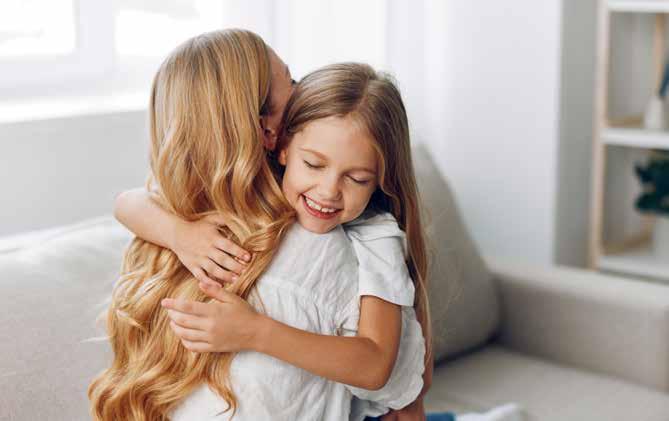
It’s a familiar scene for many parents - you’re about to leave for work, school drop-off or even just to the next room and your child clings to your leg, bursts into tears or refuses to let go. While it can be heartbreaking and exhausting in equal measure, this strong emotional response is often a sign of something very normal - separation anxiety. Separation anxiety is a healthy part of development, showing that your little one is forming strong attachments and learning about independence. That said, it can still be tough to manage - especially if you’re juggling work, siblings or just trying to leave
the house on time. Just know that with a bit of understanding and a lot of reassurance, you can support your child through this phase with confidence and compassion.
Separation anxiety is the distress some children feel when they’re apart from their parent or primary caregiver. It often begins around six to nine months of age, peaks in toddlerhood and gradually becomes less intense as children grow older and gain more confidence in the world around them.
At its core, separation anxiety is linked to your child’s growing awareness. Babies and toddlers are still learning that people and objects exist even when they’re not in sight (a developmental concept known as object permanence). Until they fully grasp that you’ll come back, being apart can feel very unsettling.
It’s also worth noting that separation anxiety doesn’t always follow a predictable path. Some children show strong signs early on, while others breeze through babyhood and develop it later - often during big life changes like starting nursery, moving house or welcoming a new sibling.
While every child is different, some common signs of separation anxiety include:
• Crying or tantrums when you leave
• Clinginess and reluctance to let go of you
• Refusing to go to sleep alone
• Waking frequently at night and needing comfort
• Becoming distressed in new places or with unfamiliar people
These reactions can be intense, especially if you’re rushing or feel guilty about leaving. However, it’s important to remember that this behaviour is not manipulative. It’s a genuine expression of fear and uncertainty, and your child is looking to you for reassurance.
Responding to separation anxiety with empathy, patience and consistency makes a big difference. You’re not trying to eliminate your little one’s feelings, but rather to help them feel safe enough to manage those feelings with support.
Start small. Try brief, low-stress separations like leaving the room for a minute or stepping outside while someone they trust stays with them. These mini departures help build trust as your child begins to realise that you do come back.
Gradually increase the time apart as they grow more comfortable and try to keep your exits calm and positive. A confident goodbye (“I’ll be back soon and I love you!”) often works better than sneaking away, which can create more anxiety over time.
Rituals offer structure and predictabilityboth of which help kids feel safe. Whether it’s a hug, a special phrase or a wave at the window, a consistent goodbye routine helps signal that a separation is coming and that it’s okay. Try to keep it short and sweet. Lingering too long can sometimes make parting more difficult.
Consistency builds trust. If you say you’ll return after lunch or pick-up, do your best to stick to that. Over time, this reliability teaches your child that goodbyes don’t mean forever and they can begin to feel more secure.
Even young toddlers benefit from hearing their feelings acknowledged. You might say, “I know it’s hard to say goodbye sometimes, but I always come back.” Naming the emotion and offering reassurance helps your child feel seen and understood.
Books are another wonderful way to explore the idea of separation in a gentle and engaging way. Look for stories that feature reunions or characters feeling nervous about being apart - they offer a lovely springboard for conversation.
It’s natural to feel flustered or guilty when your little one is upset, but do your best to remain calm. Your energy sets the tone. If you’re confident and composed, it helps your child feel that the situation is safe - even when their emotions are big.
If tears come, that’s okay. Let them have a good cry in the arms of a trusted adult and know that it doesn’t mean you’ve done
anything wrong. In fact, helping your son or daughter move through these feelings is a huge part of building emotional resilience.
For most children, separation anxiety is a temporary phase. However, if it begins to interfere with daily life, persists beyond the preschool years or is accompanied by intense fears and avoidance, it might be worth looking for support from a paediatrician or child psychologist.
Children with more extreme symptoms may be experiencing separation anxiety disorder - a more severe form that can be addressed with professional help and tailored strategies.
Separation anxiety, while tough in the moment, is a sign that your child loves and trusts you deeply. It means you’re their safe base, a place of comfort, reassurance and security, and that’s something to feel proud of.
By offering consistency, empathy and a calm presence, you’re helping your little one learn that it’s okay to feel anxious and that they can cope - with your support at first and then eventually on their own. So take a breath, hold steady and remind yourself that this too shall pass, and when it does, you’ll both be stronger for it.

Here are five ways to nurture kids’ kindness, while still helping them thrive in a results-driven world.

In a world where children are often measured by grades, trophies and the number of activities they can squeeze into a week, raising a kind child can feel like a quiet rebellion. Kindness is one of the most powerful traits we can nurture in our little ones. It lays the foundation for empathy, strengthens the relationships kids forge, boosts up their emotional wellbeing and creates a ripple effect that reaches far beyond your own family.
So how do we teach kindness - not as a one-off gesture, but as a way of life? And how do we do it without letting our children feel left behind in a world that seems to reward hustle over heart? Let’s take a look!
Whether it’s school, sports or social circles, the pressure to achieve can be intense. Kids quickly pick up on the idea that success is about coming first - and that their worth is tied solely to results.
However, here’s the truth: when we focus only on outcomes, we risk missing the quieter victories - like the courage to try something new, the patience to help a struggling friend or the resilience to keep going after a setback. What’s more, these are strengths that actually help us through so many of life’s challenges, paving the way towards success.
By praising effort, determination and the way children treat others during the process, we send a powerful message - that kindness matters and how you get there is just as important as getting there at all. You might say, “I loved how you included your friend Emma in your game today,” or, “You worked really hard on that even when it got tricky - that shows great character.”
Kindness isn’t something children just ‘pick up’ - it’s something they learn through consistent reinforcement and everyday examples. One of the most effective ways to instil kindness in kids is to make it part of your family identity. You can do this by creating small rituals that spotlight caring behaviourlike sharing ‘kind moments’ at the dinner table or encouraging kids to notice when someone else might need a hand.
Where you’re able to, it’s good to give children opportunities to help others, whether that’s through community projects, donating toys or simply writing a nice card

for someone. Above all, let your children see you being kind - to the cashier, to your neighbours, and yes, even when another driver cuts you off in traffic. These everyday interactions are powerful lessons.
Kindness isn’t just about doing nice things - it starts with understanding feelings. For kids to be truly kind, they need to recognise emotions in themselves and others. This begins with emotional vocabulary. It’s a great idea to help your child name what they’re feeling with sentences like, “It sounds like you’re feeling frustrated because you had to wait” or “You seem excited about your school trip.”
Once this has become a new norm and you’re confident your child can name their own emotions, you can guide them in reading others. This might look like asking questions such as, “How do you think your sister felt when that happened?” or “What could you do to help your friend feel better?” It may seem simple but the more children tune into how others feel, the more naturally kindness flows from them.
A little healthy competition can be a great motivator - but when it becomes the main focus, it can squash kindness. Afterall, it’s hard to feel happy for others or lend a helping
hand when you’re constantly worried about being left behind.
Instead of framing success as a race to the top, try to encourage the idea that everyone has their own path. Try to celebrate collaboration over rivalry and talk about the value of cheering others on.
You might say, “It’s great that you did well in your test - and how lovely that you helped your friend study too! That shows real teamwork.”
If your child feels disheartened by someone else’s win, validate that feeling (which is completely normal!) - but also encourage some reflection and reassurance that it doesn’t define their value.
Sometimes, especially in competitive environments, kindness can be seen as a ‘soft’ trait - something that might get children overlooked or taken advantage of. However, nothing could be further from the truth. It’s a lack of self-esteem or self-confidence that leads to these things. Conversely, kindness requires strength. It takes bravery to stand up for someone else, to forgive or to act generously when no one’s watching.
Remind your child that kindness isn’t about being a pushover - it’s about having the confidence to lead with compassion. Talk about real-life heroes who used kindness to create change and help your children feel proud of their ability to care.
If your little one needs an extra nudge towards kindness, it might be helpful to also role-play scenarios where kindness meets courage. This could be what would they do if someone was being teased - how could they be kind but also assertive?
In the end, children may or may not remember every certificate, medal or score they earned - but they’ll remember how it felt to include someone, to be included and to make someone’s day a little brighter. Raising a kind child in a competitive world doesn’t mean shielding them from ambition - it means giving them the tools to succeed while staying grounded in who they are. Afterall, kindness isn’t just a quality - it’s a strength, a skill and a way of life!
We explore the different ways kids prefer to learn - by listening, seeing or doing.
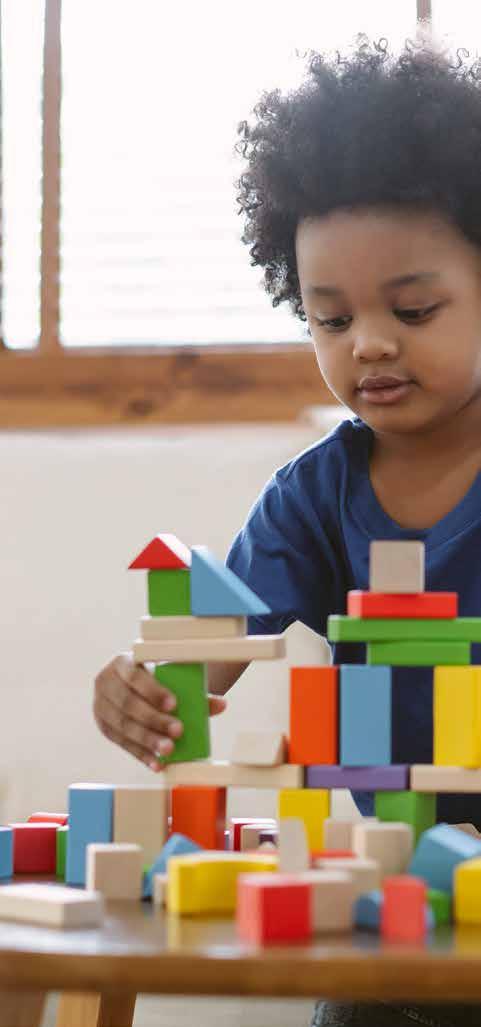

By understanding how your son or daughter processes information best, you can support their confidence, motivation and love of learning.
Children are natural learners. From the moment they’re born, they’re taking in the world - through sounds, sights, touch, movement and interaction. As they grow, their learning styles begin to emerge more clearly and no two children are exactly the same. Some may thrive when reading or looking at diagrams, others absorb everything they hear, while many learn best through physical activity and hands-on experience.
Understanding your child’s preferred learning style - whether visual, auditory or kinaesthetic - is a powerful way to support their education. It can help reduce frustration, grow their confidence and make learning feel more enjoyable and natural. It’s not about putting them in a box, but rather about giving them tools that work for them instead of against them.
When you understand how your child learns best, you’re also better equipped to support them when things get tricky. A learning wobble doesn’t have to mean they’re falling behind - it might just mean the information is being presented in a way that doesn’t click for them. Knowing their learning style helps you adjust your approach, reframe the material and bring curiosity back into the process.
It also helps strengthen the connection between yourself and your child. When you’re attuned to how your little one learns, you’re not just supporting their academics - you’re showing them that who they are matters. This kind of emotional validation
can go a long way in building trust and selfesteem. Your child learns that you're on their team, cheering them on and willing to meet them where they are - which makes all the difference.
Let’s take a closer look at the different learning styles, how to spot them and how to support your child’s development in a way that feels right for them.
The idea of learning styles is based on the understanding that people process information in different ways. While everyone uses a combination of senses to learn, most of us have a dominant style that feels more intuitive or effective.
The three most commonly recognised styles are:
• Visual learners - who learn best through seeing
• Auditory learners - who learn best through hearing
• Kinaesthetic learners - who learn best through doing and movement
While the concept of learning styles is sometimes debated in educational research, it remains a helpful framework for understanding how your little one might connect best with new information - especially in the early years, when engagement and enjoyment are key.

Visual learners absorb information most effectively when it’s presented through images, colours, charts, diagrams and written words. They often enjoy reading, drawing, looking at maps and watching demonstrations.
Signs of a visual learner:
• Loves books, storybooks and picture-led content
• Enjoys drawing or doodling
• Notices small details in their surroundings
• Uses phrases like “I see what you mean”
• Learns new words by recognising how they’re spelt
• Finds it easier to remember faces than names
How to support them:
• Use visual aids like flashcards, posters and mind maps
• Encourage colour coding and highlighting when studying
• Let them watch educational videos to reinforce lessons
• Support reading with visual cues and illustrations
• Allow them to draw out their ideas or make diagrams
• Use checklists and planners with icons or symbols
In the classroom, visual learners often benefit from sitting closer to the board, watching demonstrations and being given written instructions alongside verbal ones.
Auditory learners retain information by hearing it. They often learn best through listening to others speak, participating in discussions or repeating information out loud.
Signs of an auditory learner:
• Enjoys listening to stories, songs or audiobooks
• Can repeat things they’ve heard accurately
• Tends to talk things through while learning
• Is sensitive to tone, rhythm and sound
• Likes to sing or make up rhymes
• Often follows spoken instructions more easily than written ones
How to support them:
• Read aloud to them regularly, even if they’re independent readers
• Use songs or rhymes to reinforce key facts (times tables, spelling rules, etc.)
• Encourage them to explain what they’ve just learned out loud
• Let them record themselves reciting material and play it back
• Use discussion-based learning and group work when possible
• Ask open-ended questions that allow them to express ideas verbally
Auditory learners may struggle in environments that are noisy or distracting. When they’re concentrating, try to keep background noise to a minimum or use calm instrumental music to help them focus.
Kinaesthetic learners (sometimes called tactile learners) grasp new ideas best through hands-on experience. Movement, physical activity and using their body are essential to their learning process.
Signs of a kinaesthetic learner:
• Loves to move - finds it hard to sit still for long
• Enjoys building, crafting or using tools
• Learns better through doing, not watching or listening
• Uses gestures or physical expressions when talking
• Prefers roleplay, games or active tasks
• Is drawn to sports, dance or drama
How to support them:
• Use movement-based learning like clapping, marching or acting things out
• Offer tactile learning tools like letter tiles, number cubes or puzzle games
• Create opportunities for real-world learning
• Break up study time with short physical breaks
• Let them fidget with a small object during listening tasks

• Encourage role-playing, building models or acting out scenes from books
Kinaesthetic learners thrive in environments where they’re allowed to be physically involved. Traditional classroom setups can be a challenge, but with a little creativity, lessons can be adapted to meet their energetic needs.
Most kids aren’t only one type of learner. You may notice that your child prefers visual learning for reading, auditory techniques for music and kinaesthetic learning for science projects - and that’s completely normal. The key is to tune in to what holds their attention and seems to “click”. As your child grows, they may shift or blend styles depending on the subject, their confidence level or how the information is presented. Rather than strictly labelling your son or daughter, use learning styles as a flexible guide. The goal isn’t to limit them - it’s to open up more pathways to understanding.
When children are taught in a way that matches how they naturally learn, something magical happens - they feel seen, capable and confident.
A child who struggles with worksheets may suddenly light up during a hands-on activity. Another who finds it hard to speak up in
class may become animated when allowed to express their understanding through drawing or music.
Understanding how your little one learns also helps you advocate for them in school settings. If you know they’re a kinaesthetic learner, for example, you can speak with their teacher about ways to incorporate more active tasks. Teachers generally welcome this kind of insight - it helps them connect more meaningfully with your child.
At home, using your child’s learning style can help with everything, from homework to morning routines. Visual learners might respond well to illustrated chore charts, auditory learners may prefer verbal reminders and kinaesthetic learners may benefit from turning tasks into physical games.
Every child has a unique learning fingerprint. By taking the time to observe and understand how your child connects with the world, you’re not just helping them succeed in school - you’re showing them that learning can be joyful, personal and deeply empowering.
Whether your son or daughter learns best through pictures, sounds or movement, the most important thing they need is your encouragement, your patience and your belief in their potential.
Learning isn’t a race or a one-size-fitsall process - it’s a journey. The more we honour the way our children learn, the more confident and resilient they become, not just as students, but as people too.
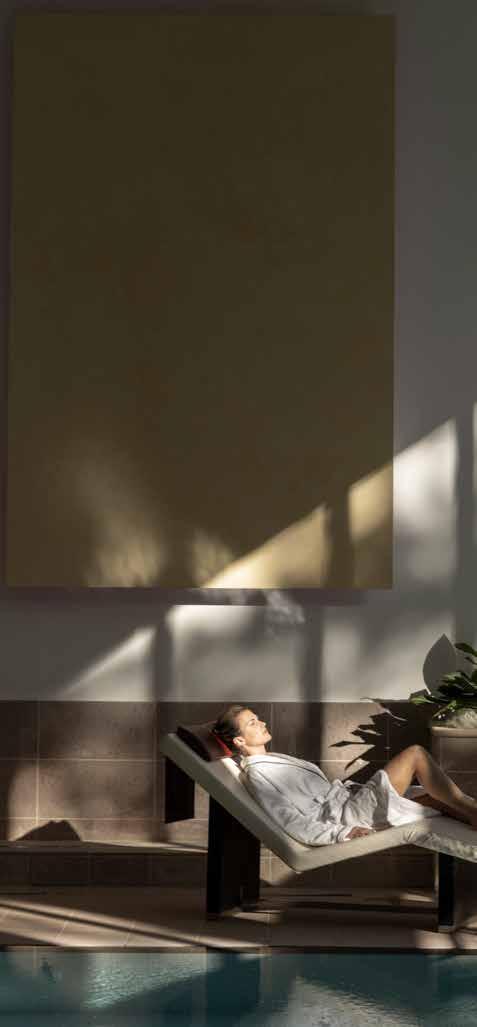

Escape the Gulf heat and immerse yourself in a rejuvenating alpine sanctuary where science, nature and the best personalised care await.
When summer in the UAE becomes relentlessly hot, discerning travellers know there’s no substitute for the crisp, refreshing air of the Alps. Nestled in the charming spa town of Merano, Italy, Palace Merano stands out as a five-star medical spa, where cutting-edge wellness meets serene natural beauty. At 325 m above sea level, the climate is cooler and cleaner - a breath of fresh air for visitors looking for the best restorative experiences.
What truly distinguishes Palace Merano is its carefully curated integration of luxury, medicine and nature. It’s not a holiday - it’s a wellbeing journey grounded in the Revital® Method, a proven scientific approach combining Western diagnostics and Traditional Chinese Medicine, fine-tuned over two decades.
Palace Merano offers you a path to lasting vitalitywhether you're a CEO needing recovery, a couple seeking reconnection or an athlete in training. Tutored by a devoted medical team and nourished by the alpine lifestyle, you’re certain to return home renewed and inspired!
The spa offers five signature Revital® programmes: Detox & Longevity, Mind & Body, Sport & Recovery, Spa and Medical Aesthetics. You can enjoy treatments ranging from bioenergetic massages, hydro-mud therapy and cryo body treatments, to comprehensive medical diagnostics and yoga therapy - all backed by personalised nutrition plans.
The six-day ‘Revital Detox for Longevity’ package is particularly special. It blends hydrotherapy, cupping massages, a gut reset protocol and algae-based wraps. It’s so popular that around 70 percent of guests return year after year.
Palace Merano features an entire 1,500 m2 medical floor, including a Bioanalysis Lab, DEXA scans, oxygen-ozone therapy, posturology analysis and aesthetic treatments. Healthcare teams are led by Dr Massimiliano Mayrhofer, who collaborated with Henri Chenot to refine the Revital Method - ensuring your experience is as much medical as it is luxurious.

Nutrition also lies at the heart of the retreat. Meals are fresh, seasonal and aligned with your programme - whether it’s detox, vegetarian or sport-based, while weekly cooking classes mean you take your wellness home with you!
Nature is a key part of the experience. You’ll stroll through alpine trails like the Tappeinerweg, unwind in shady garden nooks or cycle along the Val Passiria river. For active travellers, there’s golf, rafting or horseback riding nearby. Plus, a Sport Recovery Lab with biomechanical assessments and rehab protocols offers you precise, athletic-focused support if that’s something you’d like.
The spa encompasses 99 rooms, ranging from Comfort and Park Deluxe rooms, to suites overlooking the pool or mountains. Facilities include indoor and outdoor heated pools, a sauna, steam bath, Kneipp path and relaxation areas in the gorgeous Mediterranean gardens.
Palace Merano effortlessly blends aesthetic luxury with holistic health, against the breathtaking backdrop of the Alps. Here, every treatment, walk and meal is a thoughtful step towards longevity and wellness. This is more than a retreat - it’s a new way to live.

You know those holidays that turn into kids’ dinner-table stories, bedtime memories and “remember when I…” moments? Here is an exciting vacation option that could be exactly that!
Think white sand, turquoise waters and a non-stop adventure your children will be talking about until the next school holiday. That’s what CROSSROADS Maldives, the region’s first multi-island leisure destination, and home to Campcation 5.0 is all about - a summer camp turned dream family holiday that might just be the most fun you’ll ever have as a parent.
From now until 31st August, Hard Rock Hotel Maldives is bringing back its iconic Campcation, now in its fifth and most exciting edition yet. This is no ordinary kids’ club. Instead, it’s a bold, beat-driven island escape where children and teens (aged 4–17) are treated to daily programming that’s every bit as thrilling as it is enriching.
Set against a backdrop of powdery beaches and crystal-clear lagoons, Campcation offers aerial arts (silks, hoops and trapeze!), martial arts training from Brazilian jiu-jitsu experts, DJ and dance workshops, and even talent shows that encourage every child to shine. Add in painting, woodworking, cooking and marine discovery sessions – including coral planting and meeting a rescued sea turtle named Emma – and you’ve got the perfect mix of movement, creativity and nature.
The best part is that while your little ones are zip-lining through new experiences, you’re free to do whatever you please. With up to 40% off room rates and full-board meals for two kids under 13 included, families can unwind in the spacious Silver Family Pool Suite - a two-
storey island hideaway complete with bunk beds, a private plunge pool and plenty of room to spread out. It’s the kind of space that makes napping, snacking and family bonding all feel like part of the adventure.
Meanwhile, parents can explore the resort’s wellness spa, stroll through the marina’s boutiques, unwind by the pool or enjoy uninterrupted meals with ocean views. There’s even certified babysitting by Sittertrain Australia, for those precious grown-up moments.
From glow parties and family fun fairs to bonfires on the beach and poolside games under the stars, Campcation is more than just a programme - it’s a memory-making machine. The vibe is one of freedom and fun, with kids making fast friends, trying new things and building confidence in the most joyful way possible.
If someone’s birthday falls during your stay, you can expect full star treatment - think mascots, party games, smoothie stations and themed cakes that take centre stage. At Hard Rock, special occasions are well catered for!
Not every child wants to be flipping through the air or perfecting a kickboxing stance. For those who prefer a gentler rhythm, SAii Lagoon Maldives, just a short buggy ride away, offers the SAii Kids Summer Fun Workshop - a breezier but equally magical experience.
Hosted at Koimala and Maalimi’s Junior Beach Club & Camp, this workshop (running until 15th September) blends island adventure with creative play. Think sand painting, bracelet-making, junior science labs, snorkelling and cooking classes all rolled into one blissful day. Hair styling classes round out the fun, all set in a nurturing, flexible environment where imagination is the only limit.
With fourteen dining venues across the resort, CROSSROADS Maldives makes meal times as much a part of the adventure as the activities. From fresh seafood and gourmet pizzas to island-style grills and international bites, there’s something for every appetite.
Families can dine together, try new cuisines or stick to tried-andtrue favourites - all without leaving the island. The setting is always spectacular. Whether it’s toes in the sand, twinkling lights overhead or a panoramic ocean view, every meal is a moment.
What sets this destination apart is how thoughtfully it caters to every member of the family. Whether you’ve got toddlers in tow, curious tweens or teens who need a bit more independence, there’s space, safety and stimulation in equal measure. The design of the island encourages exploration, while the staff, programming and amenities ensure your peace of mind.
When you need a break from the schedule, you might like to head out for a dolphin cruise, a dive trip or a visit to the Marine
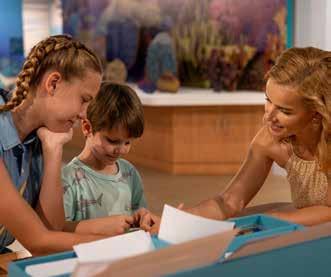
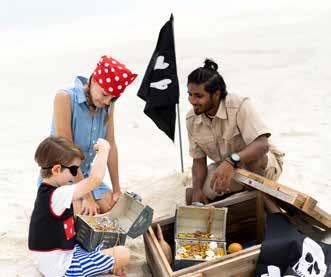
Discovery Centre, where kids can learn about ocean conservation in an engaging, hands-on way. It’s educational travel done rightwrapped in sunshine and snorkels.
Planning a family trip often comes with compromises - on activities, on rest, on the actual enjoyment of it all. However, CROSSROADS Maldives seems to have cracked the code, giving children the freedom to explore, offering parents the luxury of choice and creating a destination where amazing memories happen naturally.
It’s not just a beach break. It’s a bold, brilliant, beat-filled summer that celebrates family in all its forms. So, if your ideal getaway involves less screen time, more laughter and a whole lot of fun, this is the one to book.
Visit https://crossroadsmaldives.com for more details.
Tips to create a cooler house and how colour psychology can help you decorate.
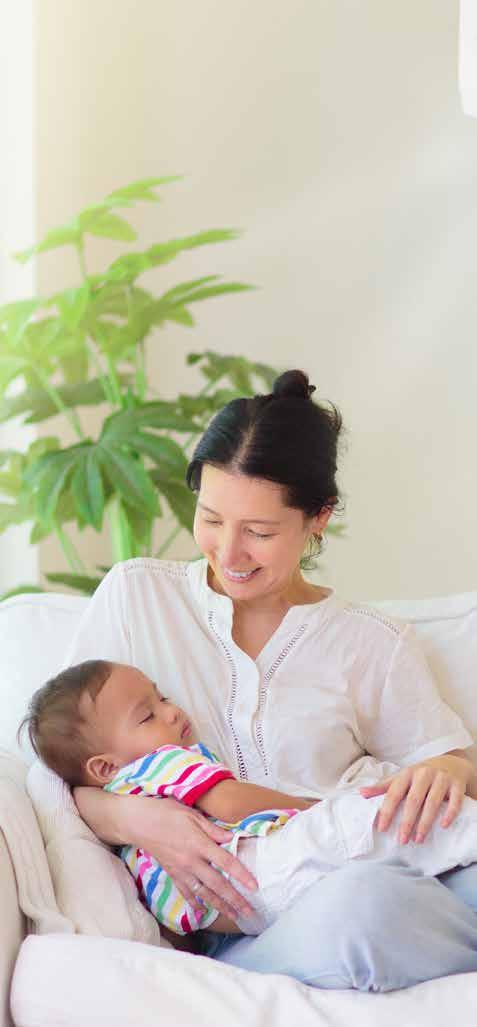

Simple but effective ways to keep your home feeling fresh and comfortable when the heat is at its peak!
Summer in the region is no small thingwith temperatures soaring well past 40°C, keeping your home cool becomes more than a matter of comfort - it’s a necessity. While air conditioning is essential, there are plenty of additional steps you can take to keep your indoor space cooler, more energy-efficient and easier to manage during the hottest months.
One of the best things you can do is to stop the heat from getting in to begin with. So, close your curtains and blinds during the hottest part of the day, especially in any rooms with direct sunlight. You might also like to opt for thermal or blackout curtains if possible, as these are designed to reduce heat gain significantly.
Reflective window film is another clever option. It’s easy to apply and helps deflect the sun’s rays, reducing the amount of heat that enters through the glass - ideal for large windows and balcony doors!
Evenings and early mornings often bring a slight drop in temperature, so make the most of those hours. Open your windows to create a cross-breeze and allow lovely fresh air to circulate around your space. Ceiling fans or standing fans can also help to move air around, making the room feel cooler without using as much energy as the AC.
If you use ceiling fans, set them to rotate counterclockwise in summer - this pushes cool air down and improves circulation.
It’s best to swap out heavy fabrics for
lighter ones during the summer. Think breathable cotton bedding, linen sofa throws and light-coloured rugs. Dark and dense materials tend to absorb and hold heat, whereas natural fabrics allow the room - and your skin - to breathe. This simple switch can make bedrooms, living rooms and sitting areas feel much more relaxed and inviting.
Did you know cooking during the day can raise the temperature in your home dramatically? On the hottest days, try to prepare your family meals in the early morning or opt for no-cook dishes, slow cookers or air fryers which generate far less heat than the oven or stove. It also helps to keep the extractor fan running after cooking to remove any lingering warm air and moisture.
Adding greenery to your home doesn’t just make it look fresh - certain indoor plants can help reduce the temperature by adding shade and releasing moisture into the air through a process called transpiration. Areca palms, snake plants and peace lilies are all well-suited for indoor spaces and they thrive in warm conditions - a win-win!
With a few thoughtful tweaks, your home can feel like a peaceful retreat from the desert sun. By layering simple strategies - from adjusting the airflow to replacing fabrics - you’ll create a cool, calm home the whole family can enjoy all summer long.
The shades you choose to decorate with have more influence than you might think. Discover how colour affects mood, energy and harmony in your living space.
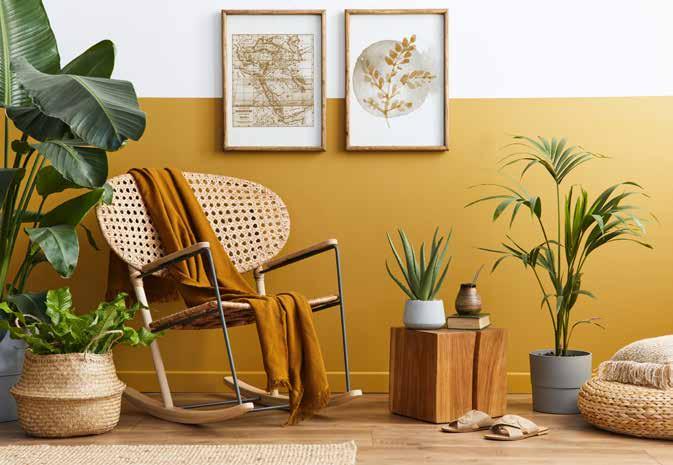
Choosing colours for your home isn’t just about style - it’s about how you want to feel. Colour has a powerful effect on our emotions and wellbeing, which is why colour psychology is a growing interest among both interior designers and everyday homeowners alike. Whether you want your home to feel calming, energising or joyful, understanding the emotional impact of different hues can help you create a space that truly supports your lifestyle.
In a region like the UAE, where many homes are flooded with natural light and modern architecture meets personal flair, your colour palette can be the key to creating the right atmosphere in every room.
Let’s start with the classics. Soft beiges, warm greys and off-whites have long been favourites for good reason! These shades are known to bring a sense of calm, space and balance to a room. Neutrals form a great base for any space, making rooms feel open and airy - which is particularly valuable in a warm climate.
They also pair beautifully with natural textures like wood, linen or rattan, adding to the sense of grounding. In bedrooms, living areas and bathrooms, a neutral palette helps create a tranquil, spa-like feel that encourages rest and relaxation.

Blue is a universally loved colour, often associated with peace, trust and clarity. Lighter tones like sky or powder blue are perfect for bedrooms and nurseries, bringing a cooling, restful quality that feels especially welcome in summer months.
Darker shades like navy or indigo lend a more sophisticated tone and work beautifully in studies or dining rooms, where they can create a sense of depth and focus. Just be mindful of how much natural light a room receives - darker blues can feel heavy in dimly lit spaces, while pale blues will always feel uplifting and fresh.
If you’re looking to add some zest and energy, yellow is your go-to. Often linked to joy, creativity and optimism, yellow works wonderfully in kitchens, playrooms or entryways where you want to welcome brightness and cheer.
Pale buttery yellows offer a subtle glow, while bold mustard or ochre bring a modern, confident edge. Orange, on the other hand, is a bit more daring - it evokes warmth, excitement and sociability. Great for social areas like lounges or dining nooks, orange can be a mood booster, particularly when used in small bursts through accessories or feature walls.
Green is deeply connected with nature, which makes it an ideal choice for creating harmony
and renewal at home. It brings the outside in and works beautifully in most roomsfrom kitchens and living rooms, to studies and bathrooms.
Sage green is especially on-trend, offering a soft, earthy tone that’s both calming and grounding. Emerald and forest greens make a striking choice for feature walls or cabinets, creating a rich and inviting atmosphere without overwhelming the senses. Green also works well with natural wood, woven textures and houseplants, enhancing that indoor-outdoor flow that is so appealing.
Red is one of the boldest colours in the spectrum - stimulating, energising and full of emotion. It’s best used sparingly in the home, as too much red can feel intense or even stressful. However, when used cleverly - perhaps as an accent in cushions, artwork or a statement wall - it can bring a sense of warmth and vitality.

Pink, on the other hand, offers a softer take on this energy. Blush tones feel romantic and calming, while deeper rose or terracotta shades can feel warm and nurturing. Pinks work well in bedrooms, dressing areas and even modern lounges, especially when paired with brass, marble or neutral tones.
In open-plan spaces - which are common in many villas and apartments - colour can be used to subtly define zones. A soothing neutral for the lounge, a cooler tone for the kitchen and a deeper shade for a dining area can all help separate each space visually, without needing physical dividers.
This is particularly helpful for families working with multifunctional rooms - for example, a soft green for a calm reading corner, or a splash of yellow in a child’s play zone.
It’s worth remembering that colour isn’t only expressed through paint. Your choice of furniture, textiles, art and even flowers all contribute to the emotional feel of a space. If you’re not ready to commit to a bold wall colour, try experimenting through cushions, rugs or wall hangings - you might be surprised by how much of a difference it makes.
There’s no strict rulebook when it comes to colour - your home should reflect your taste, culture and lifestyle. That said, taking a moment to consider how a certain colour makes you feel can help you choose more intentionally. Are you looking for peace or playfulness? Energy or ease? A quick test is to walk into a room and notice your first emotional reaction - does it feel inviting, relaxing or overstimulating? From there, you can adjust your palette to match your intention.
Ultimately, colour is a powerful yet often overlooked design tool. It affects how we feel, behave and interact with others in our home. By tuning in to colour psychology, you can curate an environment that not only looks good but also feels right for you and your family - every single day.
Showing kids how to touch animals with care and questions to ask your family before getting a pet.


Helping children learn how to treat animals with kindness, care and respect lays the foundation for a fantastic lifelong bond.
Bringing a pet into the family home can be one of the most rewarding experiences for a child - offering unconditional love, a sense of responsibility and plenty of opportunities for connection. However, for many little ones, especially toddlers and preschoolers, learning how to interact gently with animals takes time and guidance.
Whether it’s an excitable puppy, a sleepy cat or a fluffy rabbit, all animals - just like people - have boundaries. While children may not mean to be rough, their instincts often involve grabbing, hugging or patting with more enthusiasm than control. That’s why it’s so important to teach gentle hands from the very beginning.
Children learn by watching. Show them how to stroke an animal slowly and softly, using calm hands and a quiet voice. Let them see how you approach your pet carefully, wait for a sign of comfort and respond to the animal’s body language. It helps to narrate as you go - “We’re using gentle hands. Watch how I stroke her back like this - slow and soft.” Repetition is the key here! The more your little one sees and hears this, the more natural it becomes.
Young children don’t always have the coordination or impulse control to be gentle straight away, so your expectations should match their age. With babies and toddlers, it’s all about close supervision and redirection. If they try to grab fur or poke eyes, gently guide their hand and say something like, “Let’s try soft strokes instead.”
You can also encourage gentle behaviour through toys. Simply give your child a stuffed animal and show them how to pat it gently, brush its fur or offer it pretend food. This kind of play builds empathy and helps them practise before interacting with real pets.
Whenever your child interacts kindly with a pet, it’s wise to give them some specific praise. You could say, “I love how gently you stroked her ears” or, “You were so calm when she came to sit beside you.” These small moments of encouragement reinforce the good habits you want to see and help your child feel proud of their role.
If your son or daughter gets too excited or accidentally hurts your pet, stay calm and explain what went wrong - “That was too roughit scared him. Let’s try again with gentle hands.”
When children learn to treat animals with care and respect, the rewards are huge. They build stronger bonds with their pets, feel a sense of trust and responsibility, and develop empathy that extends beyond the animal world.
By teaching gentle hands, you’re not just creating a safer home - you’re planting the seeds of compassion that will grow with your child for years to come.

Here are some simple things to think about to understand if pet ownership is right for you.
Bringing a pet into your home can be one of the most joyful and rewarding decisions a family can make, but it’s not one to be taken lightly. Pets aren’t just cute companions - they’re living, feeling beings that rely on us completely. Before you fall in love with those big puppy eyes or decide a tortoise would be a ‘low maintenance’ choice (it’s actually not!), it’s worth sitting down as a family and asking yourselves a few key questions.
Whether you're dreaming of a playful pup, a chilled-out cat, a tank full of tropical fish or something a little more feathery or furry, these five questions will help your family figure out if you’re truly pet-ready.
That fluffy rabbit might look like a low-effort addition to the family, but in reality, rabbits need a lot of care - from daily exercise and social interaction, to regular grooming and specific diet requirements. The same goes for every animal. Some dogs need hours of walking each day. Some cats absolutely refuse to be cuddled. Even goldfish need a properly filtered tank and regular cleaning!
Start by doing your homework. Research the pet you're considering and look at their needs honestly. Talk to vets, visit adoption centres and read up on real-life experiences. If possible, spend time with friends or neighbours who already have that kind of pet. It can be eye-opening to see the day-to-day reality up close.
It’s easy to focus on the one-time cost of buying (or adopting) a pet, but what about the long-term costs? Food, grooming, toys, bedding, vaccinations, vet bills, pet-sitting for holidays... it all adds up. In the UAE, vet care can be quite pricey, especially if your pet needs special treatment down the line.

It’s not always about whether you have the finances, it’s also about whether that is how you want to spend your money. A good idea is to try creating a mini pet budget as a family. Research typical monthly costs and talk about who will be responsible for what. It’s a great opportunity to teach kids about financial planning and responsibility in a fun, relatable way.
Let’s be honest - no matter how enthusiastically your child promises to clean out the hamster cage or scoop the cat litter every day, the bulk of the responsibility will likely fall to the grown-ups. And that’s okay! However, it’s best to be realistic.

Before bringing a pet home, have a family chat about who will take on which tasks. Walking, feeding, cleaning, vet visits, training - write it all down and see how it feels. If it seems overwhelming, it might be a sign to wait a little longer.
Do you travel often or have unpredictable work hours? Do you live in an apartment with limited space? These lifestyle factors can all affect the kind of pet that would be right for your family - or whether getting a pet right now makes sense at all.
For example, a high-energy dog may not be happy in a small flat without a garden, while a cat might adapt more easily to apartment living. Some
pets are fine being left alone for hours, whereas others will need more companionship and structure.
Think about the rhythm of your days and weeks. Are there enough calm, consistent pockets in your schedule for daily walks, playtime or care routines? If not, could you make some changes to accommodate a pet’s needs? These are great questions to answer before you take the plunge!
Pets are not temporary guests. They’re full-blown family members and, depending on the animal, you could be committing for a decade or more. Dogs and cats can live 10-15 years. Some birds and turtles live even longer!
Are you ready for that kind of commitment? Try imagining what your family’s life will look like in five or ten years. Will your children still be young enough to enjoy the pet or will older kids be heading off to university? Will you still be living in the same home?
A good exercise is to map out the lifespan of the pet you’re considering and write down what each year might look like for your family. It can help highlight practical realities you might not have considered.
If you’ve thought through these questions as a family and still feel excited about bringing a pet into your home, congratulations! You’re likely ready to welcome a new furry (or scaly, or feathered) friend into your lives.
If the answer is “Not yet,” that’s okay too. Taking your time to make the right decision is the most caring thing you can do - both for your family and for the pet you hope to adopt one day! After all, pets bring boundless love, laughter and loyalty - and they deserve the same in return.

The Editor’s top beauty recommendations for a relaxing self-care session this month.
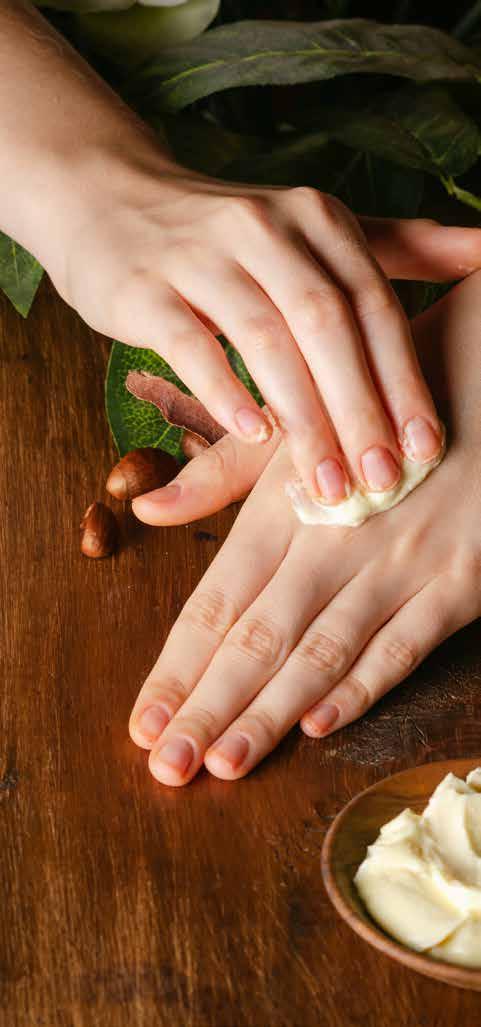


EDITOR’S BEAUTY PICKS
Who says you need a salon appointment to feel utterly pampered?
For July, I’m bringing the spa experience home with me and I’m encouraging you to do the same!
This month, I want you to imagine turning your home into a luxe spa sanctuary - where every step of your skincare and self-care ritual makes you glow from the inside out. We’re talking about a beautifully curated at-home spa kit that’s easy to assemble, with fantastic products designed to hydrate, nourish and relax you from head to toe!
Whether you’re juggling work, family, or simply in need of a moment to breathe, this ritual might just become your new go-to for creating ‘me-time’ that leaves your skin refreshed and your mind calm.

Before you even touch a single product, I’d encourage you to set the mood. Light a few candles or an aromatic diffuser with scents like lavender, orange blossom, or sandalwood - these instantly relax the senses and invite calm. Turn off your phone, dim the lights and play some soft instrumental songs or nature sounds. Pour yourself a cup of chamomile or peppermint tea - and relax!
Every great spa ritual starts with a fresh canvas. Reach for a gentle but effective cleanser that removes any impurities, without stripping your skin’s natural moisture. My top pick right now is the Dermalogica Daily Microfoliant, available at Faces and Aster Pharmacy. This cult-favourite ricebased powder activates into a creamy lather when mixed with water, gently exfoliating any dead skin cells while brightening your complexion.
Take your time - use circular motions and enjoy how this simple act clears the day off your face, revealing skin that feels soft, smooth and ready for nourishment.
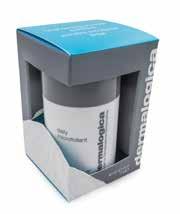
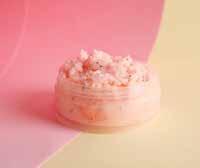
Next up, say goodbye to dullness with a body exfoliant that feels like a treat. Take a warm shower and finish with a nice body sugar scrub. This is such a refreshing way to slough off dead skin, while invigorating your senses too!
Massage it over damp skin in firm, upward circular motions, from your feet to shoulders. This step isn’t just about softness - it boosts your circulation and leaves your skin looking brighter and feeling fantastic. Then, simply rinse and pat dry, and get ready for deep hydration.

Toning is non-negotiable in my humble opinion. It balances your skin’s pH and preps it to absorb the magic that follows. I love Klairs Supple Preparation Toner or just some good quality rosewater - both easy to find in Sephora and YesStyle. Soak a cotton pad and sweep it over your face and neck, letting the gentle exfoliating acid work its subtle wonders. It’s like a little refresh button for your skin, making everything brighter, smoother and ready to drink in moisture.
If you want that professional spa glow without stepping out, The Ling Signature Facial Kit might be your answer. This two-step ritual begins with a creamy mask to clean and soften, followed by a radiance-boosting gel mask. I always let them sit for 15 minutes, and then gently rinse. Finish by massaging remaining serum into your skin for an instant lift.


Hydration is the heart in any skincare routine. Everyone’s skin is different, but personally, I recommend the Skeyndor Eternal Intensive Serum, part of their elegant Eternal collection. This lightweight serum glides on effortlessly, deeply infusing your skin with moisture for hours of plump, radiant glow.
My secret tip is to apply it onto slightly damp skin and follow it with your favourite moisturiser for maximum absorption. Trust me, this is hydration on another level, perfect for combatting the dry indoor air and UAE sun.
Here’s where the ritual becomes truly indulgent. Softly light your favourite massage candle (I like Skeyndor’s Soy & Orange Massage Candle) and wait until most of the wax has melted. Then pour a small amount into your hand to check it's a safe temperature and ready to use. Once you’re satisfied the wax has turned into a warm, silky oil, scoop a bit into your hands and start massaging your neck, shoulders, arms or legs.
Perfect for easing tension and adding an incredibly soothing element to your self-care session, I love this step - and it leaves you with silkysmooth skin!
Never forget your hard working hands and feet! Pamper them with a warm soak infused with essential oils of your choice - I like lavender! Follow this step with an exfoliating sugar scrub, and then slather on L’Occitane Shea Butter Hand Cream and Bioderma Atoderm Intensive Foot Cream to lock in softness. Slip into cosy socks and gloves if you can - and let these rich formulas absorb overnight so your skin feels amazing by morning.
I love this little self-care ritual because it’s full of sensory delights and it focuses on layered care - not just on beauty, but also on a mental reset and some tension relief. It’s also time-savvy, perfect for a relaxing 90 minutes or split over a Sunday afternoon.
Whether it’s a mid-week pick-me-up or a weekend ritual, this at-home spa kit has everything you need to turn your everyday routine into something extraordinary. Go ahead, this month give yourself the gift of total relaxation - you deserve it!





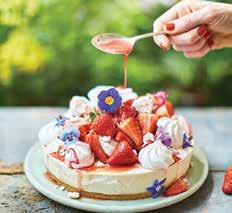
For daily inspiration, behind-the-scenes snaps and gooey videos, join the goodfood Instagram community today



